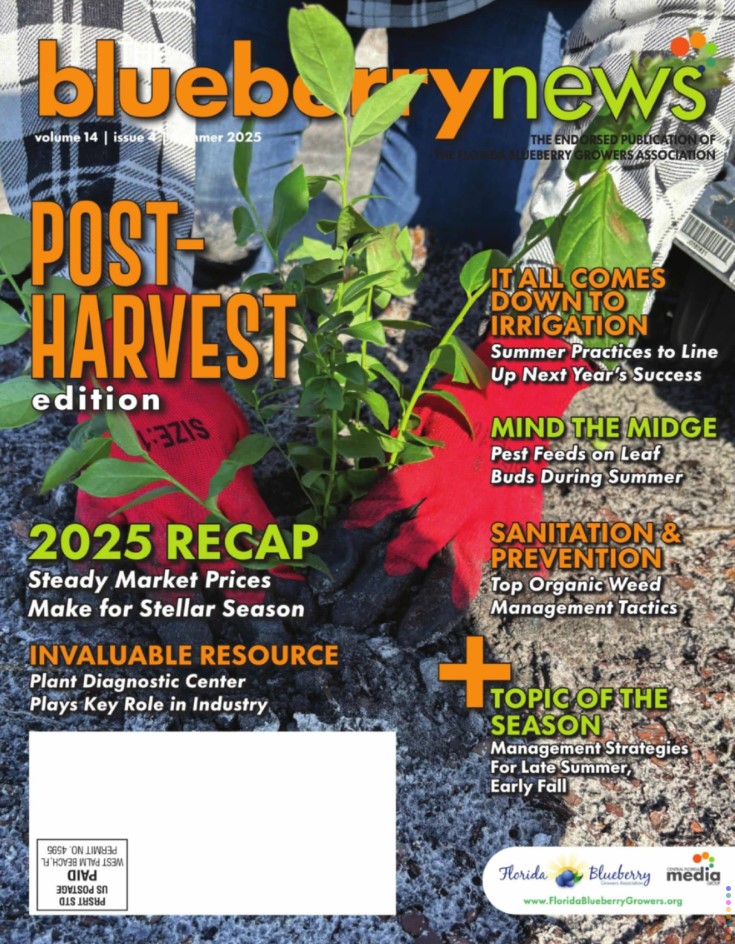Proper Irrigation Is Critical for Blueberries in Late Winter and Spring
Proper irrigation during the late winter and spring is critical as blueberry plants emerge from winter, initiate new growth, and move through the various critical growth stages of flowering, fruit set, canopy development, and fruit production.
The amount of evapotranspiration, or ET (loss of water to the atmosphere through evaporation from the soil and transpiration by the plant), that occurs in blueberry fields during the winter will vary depending on weather conditions and management practices (such as traditional deciduous versus evergreen production) but is usually significantly lower than at other times of the year. With warmer temperatures, longer day lengths, and the emergence of new growth (flowers and leaf canopy development), blueberry water use will typically increase rapidly during late winter and early spring.
Irrigation for Deciduous Systems
Research on seasonal blueberry water use in Florida’s Marion County, with a deciduous production system, showed that the least plant water use occurred during January with a steady increase in water use from January to May. A very rapid increase in water use was noted from February to March, which corresponded with plant emergence from dormancy and leaf canopy and early fruit development. Average water use for March was almost 70% of the peak water use later during the summer. Water use continues to increase through spring as temperatures increase, photoperiods lengthen, and fruit and leaf growth continues. The period from fruit set to maturity, known as the fruit development period, often coincides with dry weather in Florida and is an important period for proper irrigation management.
Irrigation for Evergreen Systems
Irrigation in an evergreen system requires somewhat different practices than those used in a deciduous system. During fall and winter, plant transpiration and water use are higher in the evergreen system than with dormant plants, since deciduous southern highbush blueberries typically defoliate during this time. Providing sufficient irrigation in the evergreen system during this time of reduced rainfall can help support healthy and intact foliage through the harvest season.
Scheduling irrigation for blueberries can be challenging due to shallow root systems and highly amended soils with variable and often limited water holding capacities. During periods of fruit development or high canopy growth, about 1 to 1.5 inches of water per week may be required. For example, mature “Emerald” plants in North-Central Florida used an average of about 2 gallons of water per day during the peak periods of water use. Under high water use conditions, irrigation efficiency can be increased by applying water frequently and in relatively small amounts to avoid oversaturation of the soil and minimize drought stress or loss of water (and nutrients) below the root zone. This is especially true where the rooting depth is shallow.
Blueberry plant water status changes throughout the day. A healthy, well-irrigated blueberry plant will recharge its water status overnight while the stomata are closed and water loss from the plant is minimal. It is important that soil water is available for uptake overnight and during predawn and early to mid-morning. The morning (after sunrise) is an important time of the day for photosynthesis and other important processes in a healthy well-irrigated blueberry plant. During hot, dry weather, these processes may be limited later in the afternoon by stomatal closure due to the plant’s need to conserve water. Therefore, it is important that plants begin the day well-hydrated.
Soil Moisture Sensors
Knowing when to apply irrigation is critical to meeting plant water needs in advance of drought stress. Soil moisture sensors can supply data on water content at different depths, providing growers with information needed for proper irrigation scheduling. This information can potentially reduce water use while maintaining or enhancing plant growth and fruit quality. The goal is to maintain soil moisture within a specified range by replacing water lost through evapotranspiration.
Common types of moisture sensors include those that measure soil water content (volumetric) and those that measure soil water tension (the force of adhesion of water to soil particles). Sensors measuring soil water content can indicate both when and how much to irrigate. See EDIS publication BUL343, “Field Devices for Monitoring Soil Water Content” (https://edis.ifas.ufl.edu/ae266) for more details. Sensors measuring soil water tension (tensiometers) may not work well in Florida’s light sandy soils, or in pine bark beds or soils highly amended with pine bark where they may lose suction.
The volume of soil measured by each sensor is limited so proper sensor placement is important for meaningful readings. Sensors should be in an area that is representative of the field in general, and away from the edge of the field to avoid border effects. For fields with significant variability (e.g., slope, wetness, cultivar type, plant age, etc.), multiple sensor sites will be necessary.
Sensor placement should be within the root zone. If only one sensor per site is used, it should be placed at a depth in the middle of the root zone. However, multiple sensors placed at different depths will provide additional information. Sensors placed near the soil/bark surface can indicate when to irrigate, and sensors in the lower root zone will provide information on depth of wetting as an indicator of how much to irrigate.
Irrigation practices can have significant effects on fertilizer use efficiency. Many Florida blueberry soils have low nutrient holding capacities so that some fertilizer elements (such as nitrogen) are readily leached below the blueberry plant’s shallow root system. If irrigation application frequencies and durations are not timed correctly, fertilizer may be leached below the root zone potentially infiltrating the ground water and requiring additional fertilizer applications. Carefully monitoring rapidly changing weather conditions, plant and crop development, and soil moisture sensor data should help with decisions needed to develop effective irrigation programs with high water and fertilizer use efficiencies.
Additional Resources
Phillips, D. A. and J.G. Williamson. 2022. Irrigation practices for southern highbush blueberry in Florida. Publication HS1432. University of Florida. https://edis.ifas.ufl.edu/publication/HS1432.
Williamson, J.G., L. Mejia, B. Ferguson, P. Miller, and D. Z. Haman. 2015. Seasonal water use of southern highbush blueberry plants in a subtropical climate. HortTechnology. 25(2):185-191. https://doi.org/10.21273/HORTTECH.25.2.185
CREDIT
JEFF WILLIAMSON, Horticultural Sciences Department, UF/IFAS
& DOUG PHILLIPS, Blueberry Extension Coordinator, UF/IFAS





